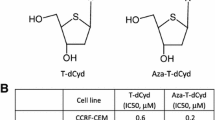Abstract
Purpose: O 6-Benzylguanine (BG), an O 6-methylguanine-DNA methyltransferase (MGMT) inactivator, potentiates the efficacy of 1,3-bis(2-chloroethyl)-1-nitrosourea (BCNU) and of other DNA chloroethylating and methylating anticancer drugs and is currently undergoing clinical trials. O 6-Benzyl-2′-deoxyguanosine (dBG), a less effective MGMT inactivator than BG in vitro, is at least as effective as BG in combination with BCNU against tumor xenografts in athymic mice. In order to identify the mechanism of dBG activation in in vivo systems we tested the metabolism, ability to inactivate MGMT, and efficacy to potentiate BCNU in vivo of two additional 9-substituted derivatives of BG, namely O 6-benzyl-9-cyanomethylguanine (CMBG) and O 6-benzylguanosine (BGS). Methods: Metabolism and disposition of these drugs was examined in athymic mice and Sprague-Dawley rats. MGMT suppression was determined in human medulloblastoma (Daoy) tumor xenografts in athymic mice following treatment with BGS, dBG, and CMBG and was compared with the loss of resistance to BCNU as determined by tumor growth delays. Results: Growth delays at 25 mg/m2 BCNU and 133 mg/m2 BG or equimolar doses of CMBG, BGS or dBG were 23.0, 2.5, 21.3 days, and 30.4 days, respectively. The above differences did not correlate with the ED50s of 0.2, 13, 11 μM, and 2 μM determined for the above compounds, respectively, in cell free extracts. Differences in the efficacies of the 9-substituted compounds did correlate, however, with the extent of their metabolic conversion to BG. The maximum concentrations of BG in blood achieved after the administration of equimolar (250 μmol/kg) doses of CMBG, BGS and dBG were 10, 30 μM, and 55 μM, respectively. Although such levels were lower than those achieved in circulation by administration of an equimolar amount of BG, BG levels persisted longer following treatments with BGS or dBG than after treatment with BG itself. Formation of BG was required for continuous and prolonged (>16 h) suppression of MGMT activity to non-detectable levels (<5 fmol/mg protein). Conclusion: Metabolism of BGS and dBG to BG explains the unexpected high efficacy of these compounds in potentiating the antitumor activity of BCNU in the athymic mouse model. The faster and more effective suppression of tumor MGMT by dBG and its greater efficacy, as compared with BGS, also correlates with a more rapid accumulation of BG in blood after dBG than after BGS administration, which results in faster and complete suppression of MGMT in Daoy xenografts. Thus, metabolism of dBG and BGS to BG appears to be the determining factor for continuous and prolonged suppression of MGMT activity, and that near complete suppression of such activity during and following BCNU administration is required for the higher efficacy of treatments. Similarly, the failure of CMBG to suppress tumor MGMT to the same extent as BGS, in spite of their similar ED50 values, could be attributed to the metabolism of this compound mainly by pathways other than conversion to BG.
Similar content being viewed by others
Author information
Authors and Affiliations
Additional information
Received 9 February 1999 / Accepted 21 June 1999
Rights and permissions
About this article
Cite this article
Kokkinakis, D., Moschel, R., Pegg, A. et al. Potentiation of BCNU antitumor efficacy by 9-substituted O 6-benzylguanines. Effect of metabolism. Cancer Chemother Pharmacol 45, 69–77 (2000). https://doi.org/10.1007/PL00006746
Issue Date:
DOI: https://doi.org/10.1007/PL00006746




